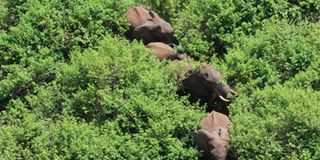Human-wildlife conflicts: Government to pay animal attack victims Sh1bn before July

Elephants in the Imenti Forest in Meru. The Government to pay out Sh1 billion as compensation to families and relatives of human-wildlife conflicts.
What you need to know:
- The Government to pay out Sh1 billion as compensation to families and relatives of human-wildlife conflicts.
- This is a welcome relief for human-wildlife survivors and victims families who have had to wait for years to be compensated.
The Government is set to pay out Sh1 billion as compensation to families and relatives of human-wildlife conflicts before the end of this financial year, Tourism Cabinet Secretary Alfred Mutua has revealed.
According to Mr Mutua, the government is banking on a new payout system to verify claims and payments to survivors and families of the victims of human-wildlife conflicts.
At a time when survivors and victims’ families have been complaining of a slow compensation process, Dr Mutua said that those affected will now receive their payouts in record time, following the introduction of the new payment system.
The CS admitted that the compensation process has been sluggish since 2020.
“It was taking long to process and authenticate the claims. But, the new scheme will make it faster from the time a claim is lodged to the time the payment is cleared,” Dr Mutua said.
The announcement is a welcome relief for human-wildlife survivors and victims families who have had to wait for years to be compensated.
The State is expected to compensate for permanent injuries leading to disability, deaths, or property damage. Compensation for anyone killed by wild animals is Sh5 million, while cases of injury resulting in permanent disability are compensated at Sh3 million.
Cases of human-wildlife conflicts are rampant in Samburu County where hippos, elephants and buffalo attacks are on the rise. Such conflicts have also been reported in Narok County, Laikipia, Baringo, Taita-Taveta and Kajiado, among others.
In Samburu, Kajiado , Narok and Laikipia,pastoralism is a major source of livelihood for many residents, but despite increased cases of animal attacks, the residents say they have no alternative.
“Cases of human wildlife conflicts here are rampant but there is no way pastoralists can avoid moving around because it is the only resource that our people have. We only urge the relevant government authorities to do their bit to ensure protection of the people and compensation for those who fall victim to wildlife attacks,” said Samson Lesuyai, a local elder.
Frequent dry spells have caused increased human-wildlife conflicts in the region as livestock and wildlife compete for pasture and water.
Three iconic elephants have been killed in Samburu in two years due to increased human-elephant conflicts. In November last year, popular bull elephant Edison was speared to death.
In 2022, bull elephants Sarara and Yeagar were both killed in a suspected conflict with herders. Sarara was one of the most beloved and famous residents of Samburu National Reserve.





